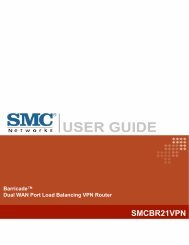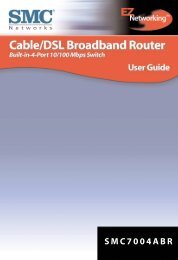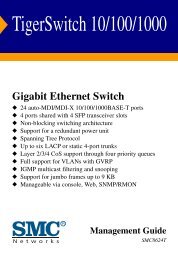Installation Guide - SMC
Installation Guide - SMC
Installation Guide - SMC
Create successful ePaper yourself
Turn your PDF publications into a flip-book with our unique Google optimized e-Paper software.
Introduction to Switching<br />
CHAPTER 2<br />
NETWORK PLANNING<br />
A network switch allows simultaneous transmission of multiple packets via<br />
non-crossbar switching. This means that it can partition a network more<br />
efficiently than bridges or routers. The switch has, therefore, been<br />
recognized as one of the most important building blocks for today’s<br />
networking technology.<br />
When performance bottlenecks are caused by congestion at the network<br />
access point (such as the network card for a high-volume file server), the<br />
device experiencing congestion (server or power user) can be attached<br />
directly to a switched port. And, by using full-duplex mode, the bandwidth<br />
to the end-user can be doubled to maximize throughput.<br />
A switch can be easily configured in any Ethernet network to significantly<br />
boost bandwidth while using conventional cabling and network cards.<br />
Application Examples<br />
VDSL provides significant savings on network installation, equipment and<br />
service fees. Internet services operate over existing phone cabling and a<br />
minimal amount of network equipment. The only changes require<br />
installing a VDSL CPE for each client, and a VDSL switch in the basement<br />
or wiring closet. Internet service can then be provided over a direct Ethernet<br />
connection from your ISP. For non-commercial environments, you can run<br />
the switch through a broadband router at the customer’s site. This will<br />
allow you to use a single-user account and ISP sharing to significantly<br />
reduce network access charges.<br />
2-1

















